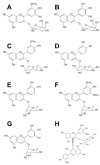Isolation and characterization of phenolic compounds and anthocyanins from Murta (Ugni molinae Turcz.) fruits. Assessment of antioxidant and antibacterial activity
- PMID: 25838172
- PMCID: PMC6272493
- DOI: 10.3390/molecules20045698
Isolation and characterization of phenolic compounds and anthocyanins from Murta (Ugni molinae Turcz.) fruits. Assessment of antioxidant and antibacterial activity
Abstract
Berry fruit consumption has become important in the promotion of human health, mainly due to their phenolic compounds, which have been associated with protection against different pathologies, as well as antimicrobial and other biological activities. Consequently, there has been a growing interest in identifying natural antioxidants and antimicrobials from these plants. This study aimed to characterize the phenolic chemical composition and anthocyanin profile of murta (Ugni molinae Turcz.) fruit, and to evaluate the antioxidant and antimicrobial activity of its extracts (ethanolic and methanolic). LC/MS of the ethanolic extracts showed the presence of three major compounds: caffeic acid 3-glu, quercetin-3-glu and quercetin, while in the methanolic acid extract they were cyanidin-3-glucoside, pelargonidin-3-arabinose and delphinidin-3-glucoside. The antioxidant activity of ethanolic extracts (DPPH· and ORAC assays) was higher than that of methanol acid extracts or purified anthocynins. Furthermore, the methanol acid extract showed an inhibitory activity against the bacteria E. coli and S. typhi similar to that of standard antibiotics. The results suggest that the antioxidant activity of the ethanolic extract is regulated by the high content of phenolic compounds and the fruit's characteristic color is due to the content of pelargonidin-3-arabinose and delphinidin-3-glucoside. The obtained results demonstrated the appreciable antioxidant and antibacterial activities, providing opportunities to explore murta extracts as biopreservatives.
Conflict of interest statement
The authors declare no conflict of interest.
Figures




Similar articles
-
Chilean berry Ugni molinae Turcz. fruit and leaves extracts with interesting antioxidant, antimicrobial and tyrosinase inhibitory properties.Food Res Int. 2017 Dec;102:119-128. doi: 10.1016/j.foodres.2017.09.073. Epub 2017 Sep 28. Food Res Int. 2017. PMID: 29195930
-
Antibacterial Properties and Effects of Fruit Chilling and Extract Storage on Antioxidant Activity, Total Phenolic and Anthocyanin Content of Four Date Palm (Phoenix dactylifera) Cultivars.Molecules. 2016 Mar 26;21(4):419. doi: 10.3390/molecules21040419. Molecules. 2016. PMID: 27023514 Free PMC article.
-
Phenolic composition and antioxidant capacity of Ugni molinae Turcz. leaves of different genotypes.Food Chem. 2017 Jan 15;215:219-27. doi: 10.1016/j.foodchem.2016.07.159. Epub 2016 Jul 29. Food Chem. 2017. PMID: 27542470
-
Phytochemicals and Traditional Use of Two Southernmost Chilean Berry Fruits: Murta (Ugni molinae Turcz) and Calafate (Berberis buxifolia Lam.).Foods. 2020 Jan 6;9(1):54. doi: 10.3390/foods9010054. Foods. 2020. PMID: 31935880 Free PMC article. Review.
-
Ugni molinae Fruit as a Source of Bioactive Compounds with Good Quality Traits.Biomed Res Int. 2021 Apr 23;2021:6683877. doi: 10.1155/2021/6683877. eCollection 2021. Biomed Res Int. 2021. PMID: 33981771 Free PMC article. Review.
Cited by
-
Obtainment of Flavonoid-Enriched Fractions from Maqui (Aristotelia chilensis) and Murta (Ugni molinae) Extracts via Preparative HPLC and Evaluation of Their Anti-Inflammatory Effects in Cell-Based Assays.Antioxidants (Basel). 2025 May 16;14(5):600. doi: 10.3390/antiox14050600. Antioxidants (Basel). 2025. PMID: 40427482 Free PMC article.
-
Chemotaxonomy, antibacterial and antioxidant activities of selected aromatic plants from Tabuk region-KSA.Heliyon. 2023 Dec 16;10(1):e23641. doi: 10.1016/j.heliyon.2023.e23641. eCollection 2024 Jan 15. Heliyon. 2023. PMID: 38192876 Free PMC article.
-
Effect of Freeze Crystallization on Quality Properties of Two Endemic Patagonian Berries Juices: Murta (Ugni molinae) and Arrayan (Luma apiculata).Foods. 2021 Feb 20;10(2):466. doi: 10.3390/foods10020466. Foods. 2021. PMID: 33672566 Free PMC article.
-
Polyphenolic Profile and Antioxidant Activity of Leaf Purified Hydroalcoholic Extracts from Seven Mexican Persea americana Cultivars.Molecules. 2019 Jan 4;24(1):173. doi: 10.3390/molecules24010173. Molecules. 2019. PMID: 30621198 Free PMC article.
-
Natural Food Colorants and Preservatives: A Review, a Demand, and a Challenge.J Agric Food Chem. 2022 Mar 9;70(9):2789-2805. doi: 10.1021/acs.jafc.1c07533. Epub 2022 Feb 24. J Agric Food Chem. 2022. PMID: 35201759 Free PMC article. Review.
References
-
- Arancibia-Avila P., Toledo F., Werner E., Suhaj M., Leontowicz H., Leontowicz M., Martinez-Ayala A.L., Paśko P., Gorinstein S. Partial characterization of a new kind of Chilean murtilla-like berries. Food Res. Int. 2011;44:2054–2062. doi: 10.1016/j.foodres.2011.01.016. - DOI
-
- Ruiz A., Hermosín-Gutiérrez I., Mardones C., Vergara C., Herlitz E., Vega M., Dorau C., Winterhalter P., von Baer D. Polyphenols and antioxidant activity of calafate (Berberis microphylla) fruits and other native berries from Southern Chile. J. Agric. Food Chem. 2010;58:6081–6089. doi: 10.1021/jf100173x. - DOI - PubMed
-
- Johnson M., Wesely E.G., Zahir H.M.I., Selvan N. In vivo and in vitro phytochemical and antibacterial efficacy of Baliospermum montanum (Wïlld.) Muell. Arg. Asian Pac. J. Trop. Med. 2010;3:894–897. doi: 10.1016/S1995-7645(10)60215-5. - DOI
-
- Zia-Ul-Haq M., Ahmad M., Mehjabeen, Jehan N., Ahmad S., Qayum M., Marwat K.I. Antimicrobial screening of selected flora of Pakistan. Arch. Biol. Sci. 2011;63:691–695. doi: 10.2298/ABS1103691Z. - DOI
MeSH terms
Substances
LinkOut - more resources
Full Text Sources
Other Literature Sources
Medical

